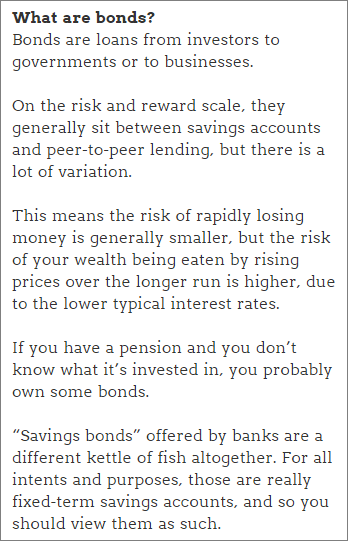To get the best lending results, compare all P2P lending and IFISA providers that have gone through 4thWay’s rigorous assessments.
Five Ways To Spot a P2P Lending Bubble
With bond interest rates plummeting to near zero, it is only a matter of time before a lot of people lost money, as was explained in yesterday's FT article Bond market fireworks flash warning signals.
interest rates plummeting to near zero, it is only a matter of time before a lot of people lost money, as was explained in yesterday's FT article Bond market fireworks flash warning signals.
When bond interest rates drop, it means people are paying too high a price to buy the bonds.
Bonds are a kind of loan (see our glossary for definition of bonds), so they share a great many characteristics with peer-to-peer lending.
(Indeed, you can get P2P bonds through some P2P lending websites.)
With that in mind, I'd like to propose five simple warning signs that you're lending in a dangerous bubble.
Unfortunately, we have less solid statistical evidence to go on than with shares and bonds, since they have a lot of history to learn from. But some simple rules won't go amiss:
1. Super low interest rates
If lenders are accepting interest rates across the safer P2P lending websites (perhaps 4thWay® Risk Rating between 9 and 19) that are less than one percentage point above the best savings accounts, you can take that as a warning that investors have got way too relaxed about the risks.
Most money in savings accounts is protected by the government and, therefore, lower down the risk scale than P2P lending.
You can see how interest rates in the P2P lending companies with lower 4thWay® Risk Ratings and bad-debt provision funds compare to savings in Safest Peer-to-Peer vs Savings Accounts.
For P2P lending websites with moderate risks (4thWay® Risk Ratings of 20-33), perhaps you could take it as a big warning sign if rates drop to less than three percentage points above savings accounts. We're still a fair way off that right now, thankfully.
2. Everyone's going up the risk scale
As a bubble of lenders compete to lend to not enough borrowers, interest rates will come down. Lenders will fight each other to lend their money and in doing so will bid downwards.
The next stage is these lenders will move up the risk scale to get higher interest rates. Once you see that lenders are shifting to higher-risk loans in large numbers (forcing interest rates down there too), you'll know that they're getting a bit too casual.
3. Incredible euphoria
As Professor Robert Shiller (a very big name in investment circles) said just recently: “A bubble is a social epidemic of enthusiasm and excitement spread by word of mouth.”
This warning sign is harder to spot, because everyone tends to get sucked in and they just can't see it for what it is from the inside: ludicrous optimism.
That optimism forces investors to do crazy things, like believe that nothing can ever go wrong.
When all reports and comments about P2P lending are incredibly buoyant like this, you need to be very wary. It's when everyone thinks it's totally safe that they all pile in, and bubbles form.
4. Professional investors stop lending
Institutions, such as hedge funds and banks, lend through P2P lending websites. If they cut their lending in half, we need to be concerned that the numbers aren't stacking up. (Although the same goes when 4thWay's own specialists say the same thing!)
5. Relaxed standards
A bubble will cause at least some P2P lending companies to relax their standards in selecting borrowers, in order to meet demand from lenders.
This will lead to such things as rising loan acceptance rates, rising late payments, rising bad debts, shrinking bad-debt provision funds and reduced transparency from the P2P lending websites about what they're up to.
These are all warning signs that we keep track of at 4thWay®, sending alerts to our newsletter subscribers if any individual P2P lending website is showing signs of losing its way. You can sign up below.
4thWay® Risk Ratings: no risk-rating system is ever perfect and they cannot consider all factors and future events. Read more about the 4thWay® Risk Ratings.


